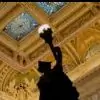The Bengal campaign

Robert Clive, 1st Baron Clive (1773), by Nathaniel Dance
On 9 January 1757, a force of 650 men, under Captain Coote and Major Kilpatrick stormed and sacked the town of Hooghly, 23 miles (37 km) north of Calcutta.On learning of this attack, the Nawab raised his army and marched on Calcutta, arriving with the main body on 3 February and encamping beyond the Maratha Ditch. Siraj set up his headquarters in Omichund's garden. A small body of their army attacked the northern suburbs of the town but were beaten back by a detachment under Lieutenant Lebeaume placed there, returning with fifty prisoners.
Clive decided to launch a surprise attack on the Nawab's camp on the morning of 4 February. At midnight, a force of 600 sailors, a battalion of 650 Europeans, 100 artillery-men, 800 sepoys and 6 six-pounders approached the Nawab's camp. At 6:00, under the cover of a thick fog, the vanguard came upon the Nawab's advanced guard, who after firing with their matchlocks and rockets, ran away. They continued forward for some distance till they were opposite Omichund's garden, when they heard the galloping of cavalry on their right. The cavalry came within 30 yards (27 m) of the British force before the line gave fire, killing many and dispersing the rest. The fog hampered visibility beyond walking distance. Hence the line moved slowly, infantry and artillery firing on either side randomly. Clive had intended to use a narrow raised causeway, south of the garden, to attack the Nawab's quarters in the garden. The Nawab's troops had barricaded the passage. At about 9:00, as the fog began to lift, the troops were overwhelmed by the discharge of two pieces of heavy cannon from across the Maratha Ditch by the Nawab's artillery. The British troops were assailed on all sides by cavalry and musket-fire from all sides. The Nawab troops then made for a bridge a mile further on, crossed the Maratha Ditch and reached Calcutta. The total casualties of Clive's force were 57 killed and 137 wounded. The Nawab's army lost 22 officers of distinction, 600 common men, 4 elephants, 500 horses, some camels and a great number of bullocks. The attack scared the Nawab into concluding the Treaty of Alinagar with the Company on 5 February, agreeing to restore the Company's factories, allow the fortification of Calcutta and restoring former privileges. The Nawab withdrew his army back to his capital, Murshidabad.
Concerned by the approach of de Bussy to Bengal and the Seven Years' War in Europe, the Company turned its attention to the French threat in Bengal. Clive planned to capture the French town of Chandernagar, 20 miles (32 km) north of Calcutta. Clive needed to know whose side the Nawab would intervene on if he attacked Chandernagar. The Nawab sent evasive replies and Clive construed this to be assent to the attack.Clive commenced hostilities on the town and fort of Chandernagar on 14 March. The French had set up defences on the roads leading to the fort and had sunk several ships in the river channel to prevent passage of the men of war. The garrison consisted of 600 Europeans and 300 sepoys. The French expected assistance from the Nawab's forces from Hooghly, but the governor of Hooghly, Nandkumar had been bribed to remain inactive and prevent the Nawab's reinforcement of Chandernagar. The fort was well-defended, but when Admiral Watson's squadron forced the blockade in the channel on 23 March, a fierce cannonade ensued with aid from two batteries on the shore. The naval squadron suffered greatly due to musket-fire from the fort. At 9:00 on 24 March, a flag of truce was shown by the French and by 15:00, the capitulation concluded. After plundering Chandernagar, Clive decided to ignore his orders to return to Madras and remain in Bengal. He moved his army to the north of the town of Hooghly.
The conspiracy
The Nawab was infuriated on learning of the attack on Chandernagar. His former hatred of the British returned, but he now felt the need to strengthen himself by alliances against the British. The Nawab was plagued by fear of attack from the north by the Afghans under Ahmad Shah Durrani and from the west by the Marathas. Therefore, he could not deploy his entire force against the British for fear of being attacked from the flanks. A deep distrust set in between the British and the Nawab. As a result, Siraj started secret negotiations with Jean Law, chief of the French factory at Cossimbazar, and de Bussy. The Nawab also moved a large division of his army under Rai Durlabh to Plassey, on the island of Cossimbazar 30 miles (48 km) south of Murshidabad.
Popular discontent against the Nawab flourished in his own court. The Seths, the traders of Bengal, were in perpetual fear for their wealth under the reign of Siraj, contrary to the situation under Alivardi's reign. They had engaged Yar Lutuf Khan to defend them in case they were threatened in any way. William Watts, the Company representative at the court of Siraj, informed Clive about a conspiracy at the court to overthrow the ruler. The conspirators included Mir Jafar, paymaster of the army, Rai Durlabh, Yar Lutuf Khan and Omichund, a Sikh merchant and several officers in the army.When communicated in this regard by Mir Jafar, Clive referred it to the select committee in Calcutta on 1 May. The committee passed a resolution in support of the alliance. A treaty was drawn between the British and Mir Jafar to raise him to the throne of the Nawab in return for support to the British in the field of battle and the bestowal of large sums of money upon them as compensation for the attack on Calcutta. On 2 May, Clive broke up his camp and sent half the troops to Calcutta and the other half to Chandernagar.
Mir Jafar and the Seths desired that the confederacy between the British and himself be kept secret from Omichund, but when he found out about it, he threatened to betray the conspiracy if his share was not increased to three million rupees ( 300,000). Hearing of this, Clive suggested an expedient to the Committee. He suggested that two treaties be drawn – the real one on white paper, containing no reference to Omichund and the other on red paper, containing Omichund's desired stipulation, to deceive him. The Members of the Committee signed on both treaties, but Admiral Watson signed only the real one and his signature had to be counterfeited on the fictitious one.[50] Both treaties and separate articles for donations to the army, navy squadron and committee were signed by Mir Jafar on 4 June.
Lord Clive testified and defended himself thus before the House of Commons of Parliament on 10 May 1773, during the Parliamentary inquiry into his conduct in India:
- "Omichund, his confidential servant, as he thought, told his master of an agreement made between the English and Monsieur Dupre [a general of the French East India Company] to attack him, and received for that advice a sum of not less than four lacks of rupees. Finding this to be the man in whom the nabob entirely trusted, it soon became our object to consider him as a most material engine in the intended revolution. We therefore made such an agreement as was necessary for the purpose, and entered into a treaty with him to satisfy his demands. When all things were prepared, and the evening of the event was appointed, Omichund informed Mr. Watts, who was at the court of the nabob, that he insisted upon thirty lacks of rupees, and five per cent. upon all the treasure that should be found; that, unless that was immediately complied with, he would disclose the whole to the nabob; and that Mr. Watts, and the two other English gentlemen then at the court, should be cut off before the morning. Mr. Watts, immediately on this information, dispatched an express to me at the council. I did not hesitate to find out a stratagem to save the lives of these people, and secure success to the intended event. For this purpose we signed another treaty. The one was called the Red, the other the White treaty. This treaty was signed by every one, except admiral Watson; and I should have considered myself sufficiently authorised to put his name to it, by the conversation I had with him. As to the person who signed admiral Watson's name to the treaty, whether he did it in his presence or not, I cannot say; but this I know, that he thought he had sufficient authority for so doing. This treaty was immediately sent to Omichund, who did not suspect the stratagem. The event took place, and success attended it; and the House, I am fully persuaded, will agree with me, that, when the very existence of the Company was at stake, and the lives of these people so precariously situated, and so certain of being destroyed, it was a matter of true policy and of justice to deceive so great a villain."
The approach march
On 12 June, Clive was joined by Major Kilpatrick with the rest of the army from Calcutta at Chandernagar. The combined force consisted of 613 Europeans, 171 artillery-men controlling eight field pieces and two howitzers, 91 topasses, 2100 sepoys and 150 sailors. The army set out for Murshidabad on 13 June. Clive sent out the Nawab's messengers with a letter declaring his intention to march his army to Murshidabad to refer their complaints with regard to the treaty of 9 February with the principal officers of the Nawab's government. The Indian troops marched on shore while the Europeans with the supplies and artillery were towed up the river in 200 boats. On 14 June, Clive sent a declaration of war to Siraj. On 15 June, after ordering an attack on Mir Jafar's palace in suspicion of his alliance with the British, Siraj obtained a promise from Mir Jafar to not join the British in the field of battle. He then ordered his entire army to move to Plassey, but the troops refused to quit the city until the arrears of their pay were released. The delay caused the army to reach Plassey only by 21 June.
By 16 June, the British force had reached Paltee, 12 miles (19 km) north of which lay the strategically important town and fort of Katwa. It contained large stores of grain and military supplies and was covered by the river Aji. On 17 June, Clive despatched a force of 200 Europeans, 500 sepoys, one field piece and a small howitzer under Major Coote of the 39th Foot to capture the fort. The detachment found the town abandoned when they landed at midnight. At daybreak on 19 June, Major Coote went to the bank of the river and waved a white flag, but was met only by shot and a show of defiance by the governor. Coote split his Anglo-Indian force; the sepoys crossed the river and fired the ramparts while the Europeans crossed farther up from the fort. When the garrison saw the advancing troops, they gave up their posts and fled north. Hearing of the success, Clive and the rest of the army arrived at Katwa by the evening of 19 June.
At this juncture, Clive faced a dilemma. The Nawab had reconciled with Mir Jafar and had posted him on one flank of his army. Mir Jafar had sent messages to Clive, declaring his intention to uphold the treaty between them. Clive decided to refer the problem to his officers and held a council of war on 21 June. The question Clive put before them was whether, under the present circumstances, the army, without other assistance, should immediately cross into the island of Cossimbazar and attack the Nawab or whether they should fortify their position in Katwa and trust to assistance from the Marathas or other Indian powers. Of the twenty officers attending the council, thirteen including Clive were against immediate action, while the rest including Major Coote were in favour citing recent success and the high spirits of the troops. The council broke up and after an hour of deliberation, Clive gave the army orders to cross the Bhagirathi River on the morning of 22 June.
At 1:00, on 23 June, they reached their destination beyond the village of Plassey. They quickly occupied the adjoining mango grove, called Laksha Bagh, which was 800 yards (730 m) long and 300 yards (270 m) wide and enclosed by a ditch and a mud wall. Its length was angled diagonally to the Bhagirathi River. A little to the north of the grove at the bank of the river stood a hunting lodge enclosed by a masonry wall where Clive took up his quarters. The grove was about a mile from the Nawab's entrenchments. The Nawab's army had been in place 26 hours before Clive's. A French detachment under Jean Law would reach Plassey in two days. Their army lay behind earthen entrenchments running at right angles to the river for 200 yards (180 m) and then turning to the north-eastern direction for 3 miles (4.8 km). There was a redoubt mounted by cannon at this turning along the entrenchment. There was a small hill covered by trees 300 yards (270 m) east of the redoubt. 800 yards (730 m) towards the British position was a small tank and 100 yards (91 m) further south was a larger tank, both surrounded by a large mound of earth.
Order of battle
| The Anglo-Indian Army (East India Company) |
| Unit | Commander | Complement |
| Commander-in-Chief | Col. Robert Clive |
|
| 1st Division (1st Madras European Regiment) | Maj. James Kilpatrick |
|
| 2nd Division (1st Madras & Bombay European Regiments) | Maj. Alexander Grant |
|
| 3rd Division (HM's 39th Regiment of Foot) | Maj. Eyre Coote |
|
| 4th Division (Bombay European Regiment) | Maj. George Frederick Guah (or Guapp) |
|
| Sepoys (1st Bengal Native Infantry) |
| 2100 |
| Artillery (9 Battery, 12th Regiment, Royal Artillery) | Lt. Hater
Cpt. William Jennings | 150 (100 artillerymen, 50 sailors)
6 field pieces
2 howitzers |
| The Bengal Army |
| Unit | Commander | Complement |
| Commander-in-Chief | Siraj-ud-daulah |
|
| Advanced Cavalry | Mir Madan
Mohan Lal | 5,000 cavalry
7,000 infantry |
| Left Wing | Mir Jafar |
|
| Centre | Yar Lutuf Khan |
|
| Right Wing | Rai Durlabh |
|
| Artillery |
| 53 pieces (mostly 32, 24 and 18-pounders) |
| French Artillery | St. Frais | 50 French artillerymen
6 field pieces |
[edit] Battle

A plan of the Battle of Plassey, fought 23 June 1757 by Col. Robert Clive, against the Nawab of Bengal. Depiction of the battlefield, with explanations of troop movements.
At daybreak on 23 June, the Nawab's army emerged from their camp and started advancing towards the grove. Their army consisted of 35,000 infantry of all sorts, armed with matchlocks, swords, pikes and rockets and 18,000 cavalry, armed with swords or long spears, interspersed by 53 pieces of artillery, mostly 32, 24 and 18-pounders. The army also included a detachment of about 50 French artillerymen under de St. Frais directing their own field pieces. The French took up positions at the larger tank with four light pieces advanced by two larger pieces, within a mile of the grove. Behind them were a body of 5,000 cavalry and 7,000 infantry commanded by the Nawab's faithful general Mir Madan Khan and Mohan Lal. The rest of the army numbering 45,000 formed an arc from the small hill to a position 800 yards east of the southern angle of the grove, threatening to surround Clive's relatively smaller army. The right arm of their army was commanded by Rai Durlabh, the centre by Yar Lutuf Khan and the left arm closest to the British by Mir Jafar.
Clive watched the situation unfolding from the roof of the hunting lodge, anticipating news from Mir Jafar. He ordered his troops to advance from the grove and line up facing the larger tank. His army consisted of 750 European infantry with 100 Topasses, 2100 sepoys and 100 artillery-men assisted by 50 sailors. The artillery consisted of eight 6-pounders and two howitzers. The Europeans and Topasses were placed in the centre of the line in four divisions, flanked on both sides by three 6-pounders. The sepoys were placed on the right and left in equal divisions. Clive posted two 6-pounders and two howitzers behind some brick-kilns 200 yards (180 m) north of the left division of his army to oppose the French fire.
The battle begins
At 8:00, the French artillery at the larger tank fired the first shot, killing one and wounding another from the grenadier company of the 39th Regiment. This, as a signal, the rest of the Nawab's artillery started a heavy and continuous fire. The advanced field pieces of the British opposed the French fire, while those with the battalion opposed the rest of the Nawab's artillery. Their shots did not serve to immobilize the artillery but hit the infantry and cavalry divisions. By 8:30, the British had lost 10 Europeans and 20 sepoys. Leaving the advanced artillery at the brick kilns, Clive ordered the army to retreat back to relative shelter of the grove. The rate of casualties of the British dropped substantially due to the protection of the embankment.
Death of Mir Madan Khan
At the end of three hours, there was no substantial progress and the positions of both sides had not changed. Mir Jafar had not shown any signs of cooperation with the British. Clive called a meeting of his staff to discuss the way ahead. It was concluded that the present position should be maintained till after nightfall, and an attack on the Nawab's camp should be attempted at midnight. Soon after the conference, a heavy rainstorm occurred. The British used tarpaulins to protect their ammunition, while the Nawab's army took no such precautions. As a result, their powder got drenched and their rate of fire slackened, while Clive's artillery kept up a continuous fire. As the rain began to subside, Mir Madan Khan, assuming that the British guns were rendered ineffective by the rain, led his cavalry to a charge. However, the British countered the charge with heavy grape shot, mortally wounding Mir Madan Khan and driving back his men.
Siraj had remained in his tent throughout the cannonade surrounded by attendants and officers assuring him of victory. When he heard that Mir Madan were mortally wounded, he was deeply disturbed and attempted reconciliation with Mir Jafar, flinging his turban to the ground, entreating him to defend it. Mir Jafar promised his services but immediately sent word of this encounter to Clive, urging him to push forward. The messenger did not reach Clive until after the battle. Following Mir Jafar's exit from the Nawab's tent, Rai Durlabh urged Siraj to withdraw his army behind the entrenchment and advised him to return to Murshidabad leaving the battle to his generals. Siraj complied with this advice and ordered the troops under Mohan Lal to retreat behind the entrenchment. He then mounted a camel and accompanied by 2,000 horsemen set out for Murshidabad.
[edit] Battlefield manoeuvres

Soldier of the 39th Regiment of Foot (c. 1742)
At about 14:00, the Nawab's army ceased the cannonade and began turning back north to their entrenchments, leaving St. Frais and his artillery without support. Seeing the Nawab's forces retiring, Major Kilpatrick, who had been left in charge of the British force while Clive was resting in the hunting lodge, recognized the opportunity to cannonade the retiring enemy if St. Frais' position could be captured. Sending an officer to Clive to explain his actions, he took two companies of the 39th Regiment and two field pieces and advanced towards St. Frais' position. When Clive received the message, he hurried to the detachment and reprimanded Kilpatrick for his actions without orders and commanded to bring up the rest of the army from the grove. Clive himself then led the army against St. Frais' position which was taken at 15:00 when the French artillery retreated to the redoubt of the entrenchment, setting up for further action.
As the British force moved towards the larger tank, it was observed that the left arm of the Nawab's army had lingered behind the rest. When the rear of this division reached a point in a line with the northern point of the grove, it turned left and marched towards the grove. Clive, unaware that it was Mir Jafar's division, supposed that his baggage and stores were the intended target and sent three platoons under Captain Grant and Lieutenant Rumbold and a field piece under John Johnstone, a volunteer, to check their advance. The fire of the field piece halted the advance of the division, which remained isolated from the rest of the Nawab's army.
Meanwhile, the British field pieces began a cannonade on the Nawab's camp from the mound of the larger tank. As a result, many of the Nawab's troops and artillery started coming out of the entrenchment. Clive advanced half of his troops and artillery to the smaller tank and the other half to a rising ground 200 yards to the left of it and started bombarding the entrenchment with greater efficiency, throwing the approaching trains into confusion. The Nawab's troops shot their matchlocks from holes, ditches, hollows and from bushes on the hill east of the redoubt while St. Frais kept up his artillery fire from the redoubt. Cavalry charges were also repulsed by the British field pieces. However, the British force sustained most of its casualties in this phase.
At this point, Clive realized that the lingering division was Mir Jafar's and concentrated his efforts at capturing the redoubt and hill east of it. Clive ordered a three-pronged attack with simultaneous attacks by two detachments on the redoubt and the hill supported by the main force in the centre. Two companies of grenadiers of the 39th Regiment, under Major Coote took the hill at 16:30 after the enemy fled without firing a shot. Coote pursued them across the entrenchment. The redoubt was also taken after St. Frais was forced to retreat. By 17:00, the British occupied the entrenchment and the camp left by a dispersing army. The British troops marched on and halted 6 miles (9.7 km) beyond Daudpur at 20:00.
The British losses were estimated at 22 killed and 50 wounded. Of the killed, three were of the Madras Artillery, one of the Madras Regiment and one of the Bengal European Regiment. Of the wounded, four were of the 39th Regiment, three of the Madras Regiment, four of the Madras Artillery, two of the Bengal European Regiment, one of the Bengal Artillery and one of the Bombay Regiment. Of the losses by the sepoys, four Madras and nine Bengal sepoys were killed while nineteen Madras and eleven Bengal sepoys were wounded. Clive estimates that the Nawab's force lost 500 men, including several key officers.
Aftermath
In the evening of 23 June, Clive received a letter from Mir Jafar asking for a meeting with him. Clive replied that he would meet Mir Jafar at Daudpur the next morning. When Mir Jafar arrived at the British camp at Daudpur in the morning, Clive embraced him and saluted him as the Nawab of Bengal, Bihar and Orissa. He then advised Mir Jafar to hasten to Murshidabad to prevent Siraj's escape and the plunder of his treasure. Mir Jafar reached Murshidabad with his troops on the evening of 24 June. Clive arrived at Murshidabad on 29 June with a guard of 200 European soldiers and 300 sepoys in the wake of rumours of a possible attempt on his life. Clive was taken to the Nawab's palace, where he was received by Mir Jafar and his officers. Clive placed Mir Jafar on the throne and acknowledging his position as Nawab, presented him with a plate of gold rupees.
Siraj-ud-daulah had reached Murshidabad at midnight on 23 June. He summoned a council where some advised him to surrender to the British, some to continue the war and some to prolong his flight. At 22:00 on 24 June, Siraj disguised himself and escaped northwards on a boat with his favourite women and valuable jewels. His intention was to escape to Patna with aid from Jean Law. At midnight on 24 June, Mir Jafar sent several parties in pursuit of Siraj. On 2 July, Siraj reached Rajmahal and took shelter in a deserted garden but was soon discovered and betrayed to the local military governor, the brother of Mir Jafar, by a man who was previously arrested and punished by Siraj. His fate could not be decided by a council headed by Mir Jafar and was handed over to Mir Jafar's son, Miran, who had Siraj murdered that night. His remains were paraded on the streets of Murshidabad the next morning and were buried at the tomb of Alivardi Khan.
According to the treaty drawn between the British and Mir Jafar, the British acquired all the land within the Maratha Ditch and 600 yards (550 m) beyond it and the zamindari of all the land between Calcutta and the sea. Besides confirming the firman of 1717, the treaty also required the restitution, including donations to the navy squadron, army and committee, of 22,000,000 rupees ( 2,750,000) to the British for their losses. However, since the wealth of Siraj-ud-daulah proved to be far less than expected, a council held with the Seths and Rai Durlabh on 29 June decided that one half of the amount was to be paid immediately – two thirds in coin and one third in jewels and other valuables. As the council ended, it was revealed to Omichand that he would receive nothing with regard to the treaty, hearing which he went insane.

A map of the Indian subcontinent showing the British possessions in 1767

A map of the Indian subcontinent showing the British possessions in 1744
Effects
As a result of the battle of Plassey, the French were no longer a significant force in Bengal. In 1759, the British defeated a larger French garrison at Masulipatam, securing the Northern Circars. By 1759, Mir Jafar felt that his position as a subordinate to the British could not be tolerated. He started encouraging the Dutch to advance against the British and eject them from Bengal. In late 1759, the Dutch sent seven large ships and 1400 men from Java to Bengal under the pretext of reinforcing their Bengal settlement of Chinsura even though Britain and Holland were not officially at war. Clive, however, initiated immediate offensive operations by land and sea and defeated the much larger Dutch force on 25 November 1759 in the Battle of Chinsura. The British then deposed Mir Jafar and installed Mir Qasim as the Nawab of Bengal. The British were now the paramount European power in Bengal. When Clive returned to England due to ill-health, he was rewarded with an Irish peerage, as Lord Clive, Baron of Plassey and also obtained a seat in the English House of Commons.
In southern India, the Third Carnatic War continued with several naval skirmishes taking place off the Coromandel Coast. Fort St. David was taken by the French on 2 June 1758 by de Lally. In November 1758, the French started siege operations on Madras until they were forced to raise the siege in February 1760 when a squadron under Admiral Pocock arrived to reinforce the British. The struggle continued in areas of the Deccan and Hyderabad such as Arcot, Wandewash, Tanjore and Cuddalore, culminating in 1761 when Col. Eyre Coote defeated a French garrison under de Lally, supported by Hyder Ali at Pondicherry. The French were returned Pondicherry in 1763 by way of the Treaty of Paris but they never again regained their former stature in India. The British would, in effect, emerge as rulers of the subcontinent in subsequent years.









































